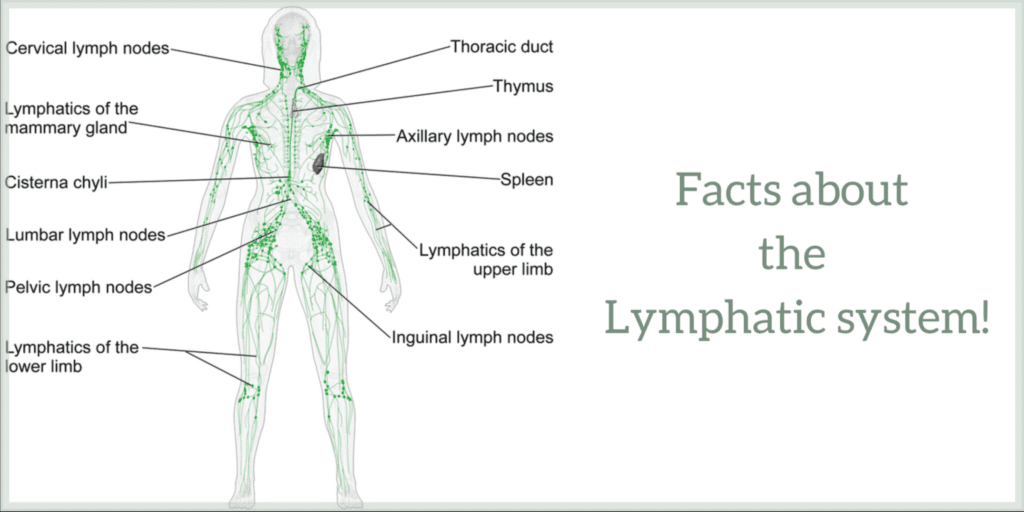The functions of the lymphatic system are discussed in detail in this article. The lymphatic system is an integral aspect of your immune system. It is a collection of organs and tissues whose job is to recycle the body’s colourless, watery lymph fluid into the bloodstream.
The lymphatic system has numerous roles, including removing waste products from cells. The lymphatic system can become dysfunctional due to obstructions, illnesses, or infections.
About 20 litres of plasma travel through your arterial and capillary systems daily. Plasma transports nutrients to cells and tissues and removes waste materials from the same areas. Veins return about 17 litres to the body’s blood supply. The remaining three litres make their way into your tissues via the capillaries. This surplus fluid, now known as lymph, is collected by the lymphatic system. The lymphatic system then transports the fluid until it may be reabsorbed into the bloodstream.
Parts of the lymphatic system
Various components make up the lymphatic system. The organs and tissues include the spleen, thymus, tonsils and adenoids, bone marrow, Peyer’s patches, lymph, lymph nodes, lymphatic vessels, collecting ducts, and the appendix.
The spleen is the body’s largest lymphatic organ and sits just under the left side of the rib cage, just above the stomach. The spleen carries out white blood cell production, blood filtration, and blood storage.
The thymus gland sits in the upper chest, just behind the breastbone. It induces the development of a type of white blood cell that helps the body fight off infections.
To protect the body from harmful bacteria and viruses, the tonsils and adenoids act as a filter for the food and air you take in. They protect your body from pathogens and other potentially harmful substances.
The soft, spongy tissue found in the hip and breast bones is called “bone marrow.” The bone marrow produces all three types of blood cells (red blood cells, white blood cells, and platelets).
Absorbing lipids from the digestive tract is one of the functions of the lymphatic system. Fats and proteins are found in the lymph fluids that come from your digestive system. Lymph is reabsorbed into the bloodstream via the lymphatic system.
Parts of the lymphatic system continued
Peyer’s patches are lymph node masses found in the lining of the small intestine. Intestinal lymphoid cells patrol for and eliminate harmful microbes.
The appendix houses lymphoid tissue, which can kill germs before it enters the body through the intestinal wall. Scientists also think the appendix helps repopulate our stomach with healthy bacteria after an infection has gone.
Lymph, also known as lymphatic fluid, contains fluid and other substances that are not reabsorbed by the capillaries after draining from cells and tissues. Proteins, minerals, lipids, nutrients, broken cells, cancer cells, and alien invaders like bacteria, viruses, etc., are some of the other substances. White blood cells, commonly known as lymphocytes, are transported via lymph to fend off infections. Keeping fluid levels stable is included in the functions of the lymphatic system.
Bean-shaped lymph nodes filter lymph as it moves through the body and performs important functions such as monitoring and cleaning. The lymph nodes filter out the damaged cells and cancer cells.
Lymphatic vessels are the capillary network and the extensive tube system throughout the body responsible for draining lymph from tissues.
The lymph is drained from the veins into the right and left lymphatic duct, commonly known as the thoracic duct. Lymph is reabsorbed into the circulatory system via these ducts and the subclavian vein.
What can I do to protect my lymphatic system?
Warding off pathogens is one of the functions of the lymphatic system. Lymphatics are an element of the immune system. Lymphocytes, or white blood cells, and other immune cells, are created and released to watch out for and eliminate dangerous invaders. Bacteria, viruses, parasites, and fungi are all examples of possible alien invaders.
Maintaining a robust and healthy lymphatic system requires the following steps:
- Avoid potentially harmful compounds like those in household cleansers and pesticides as much as possible. If these substances accumulate in your body, waste removal may become compromised.
- Maintaining a healthy level of hydration is essential for the free flow of lymph.
- Focus on keeping a healthy body and mind by sticking to a routine of regular exercise and nutritious food.
If you have persistent exhaustion (severe tiredness) or unusual swelling that lasted at least more than a few weeks or caused you significant discomfort, you should make an appointment with your doctor.



